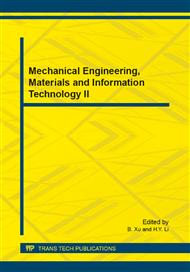[1]
T. J. Whitney, T.W. Chou. Modeling of 3-D angle-interlock textile structural composite. Journal of Composite Material, 1989, 23(9): 890-911.
DOI: 10.1177/002199838902300902
Google Scholar
[2]
J. Liang, S.Y. Du, Y.C. Han. Elastic constant forecasting methods of three-dimensional braided composite material with one special kind of micro-crack defects[J]. Acta Materiae Compositae Sinica. 1997, 14(1): 101-107.
Google Scholar
[3]
Ma, Chang-Long, Jean-Ming Yang and Tsu-Wei Chou. Elastic stiffness of three-dimensional braided textile structure composites. ASTM STP 893. Composite Materials: Testing and Design, Philadelphia, 1986: 404-421. ].
DOI: 10.1520/stp35360s
Google Scholar
[4]
J.M. Yang, C.L. Ma and T.W. Chou. Fiber Inclination Model of Three Dimensional Textile Structural Composites. Journal of Composite Material, 1986, 20(1): 472-484.
DOI: 10.1177/002199838602000505
Google Scholar
[5]
Xu Kun, XuXiwu, Wang Hai. Geometric Modeling and Stiffness Prediction of Three-dimensional Four-way Braided Material [J]. Acta Materiae Compositae Sinica, 2005, 22 (1): 133-138.
Google Scholar
[6]
Wang Bing, Wu Linzhi. Carbon Fiber Reinforced Compression Performance Pyramid Lattice Sandwich Structure [J]. Acta Materiae Compositae Sinica, 2010, 27 (1): 133-138.
Google Scholar
[7]
Kalidindi S.R., Franco E. Numerical evaluation of iso strain and weighted-average models for elastic moduli of t here-dimensional composites. Composites Science and Technology, 1997, 57(3): 293-305.
DOI: 10.1016/s0266-3538(96)00119-4
Google Scholar
[8]
X.K. Sun, C.J. Sun. Mechanical properties of three-dimensional braided composites. Composite Structures. 2004, 65 (3-4): 485-492.
DOI: 10.1016/j.compstruct.2003.12.009
Google Scholar
[9]
D.E. Whyte, C.M. PaStore, F.K. Ko. A fabric geometry model for 3-D braid reinforced FP/AI-Li composites. In: Inter SAMPE Metals Cont, Competitive Advances in Metals/Metal Processing, Cherry Hill, Aug. 1987: 87-91.
Google Scholar


